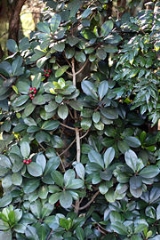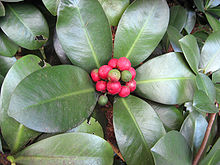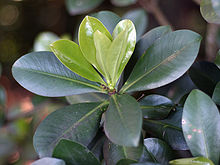
Elingamita
Encyclopedia
Elingamita is a genus in the Myrsinaceae family of plants. It consists of a single species, Elingamita johnsonii, a tree or shrub endemic to the Three Kings Islands
approximately 55 km north of the North Island
of New Zealand
. The entire world population of the tree is confined to a small rocky island and two nearby islets, and thus is vulnerable to destruction by fire or other unforeseen events. Elingamita johnsonii grows as a shrub or small tree in Pōhutukawa
(Metrosideros excelsa) forest and coastal scrub on West island. It also occurs on two rocky islets of the Princes Group; on one of these islets, Hinemoa Rock, it grows as an emergent canopy tree in exposed places. The relationship of Elingamita to other genera of the Myrsinaceae remains to be properly established. Discovered in 1950, Elingamita johnsonii takes its name from the steamer Elingamite
, which was wrecked on West Island in 1902. The natural range is currently free of rodents, but the fruit is known to be very palatable to rats.
 Elingamita johnsonii is a stoutly branched tree up to 8 m tall, but usually much less than that. The bark is grey and smooth. The dark green leaves, 10 to 18 cm long and 4 to 9 cm wide, are smooth with a satin-like gloss. The leaf stems are short, about 1 cm long. The tiny, pale yellow to pink flowers appear in terminal panicles between February and May, and sometimes also between August and November. Male and female flowers generally occur on separate trees. The attractive grape-like bunches of red fruit take a year or more to ripen. Each fruit is a globe-shaped drupe up to 20 mm in diameter which encloses a single seed. While the foliage could be mistaken for that of a Karaka tree (Corynocarpus laevigatus), the bunches of red, fleshy fruit are very distinctive and may be seen on the tree at any time of the year. The fruits are edible, the white flesh tasting like a salty apple.
Elingamita johnsonii is a stoutly branched tree up to 8 m tall, but usually much less than that. The bark is grey and smooth. The dark green leaves, 10 to 18 cm long and 4 to 9 cm wide, are smooth with a satin-like gloss. The leaf stems are short, about 1 cm long. The tiny, pale yellow to pink flowers appear in terminal panicles between February and May, and sometimes also between August and November. Male and female flowers generally occur on separate trees. The attractive grape-like bunches of red fruit take a year or more to ripen. Each fruit is a globe-shaped drupe up to 20 mm in diameter which encloses a single seed. While the foliage could be mistaken for that of a Karaka tree (Corynocarpus laevigatus), the bunches of red, fleshy fruit are very distinctive and may be seen on the tree at any time of the year. The fruits are edible, the white flesh tasting like a salty apple.
 The plant is sometimes available for sale by specialist nurseries. Propagation is easy from seed although it may take a year to germinate. Seedlings are vigorous and thrive in semi-shade and prefer a fertile, free draining soil. Once they are established, plants do well in full sun. Cuttings are slow to strike. Male and female plants are required for the production of fruit to ensure that fruit are produced. In gardens, Elingamita johnsonii makes an excellent specimen tree for frost-free areas. It is highly sensitive to cold and intolerant of frost.
The plant is sometimes available for sale by specialist nurseries. Propagation is easy from seed although it may take a year to germinate. Seedlings are vigorous and thrive in semi-shade and prefer a fertile, free draining soil. Once they are established, plants do well in full sun. Cuttings are slow to strike. Male and female plants are required for the production of fruit to ensure that fruit are produced. In gardens, Elingamita johnsonii makes an excellent specimen tree for frost-free areas. It is highly sensitive to cold and intolerant of frost.
Three Kings Islands
The Three Kings Islands or Manawa Islands are a group of 13 islands about northwest of Cape Reinga, the northernmost point of the North Island of New Zealand, where the South Pacific Ocean and Tasman Sea converge. They measure about 4.86 km² in area...
approximately 55 km north of the North Island
North Island
The North Island is one of the two main islands of New Zealand, separated from the much less populous South Island by Cook Strait. The island is in area, making it the world's 14th-largest island...
of New Zealand
New Zealand
New Zealand is an island country in the south-western Pacific Ocean comprising two main landmasses and numerous smaller islands. The country is situated some east of Australia across the Tasman Sea, and roughly south of the Pacific island nations of New Caledonia, Fiji, and Tonga...
. The entire world population of the tree is confined to a small rocky island and two nearby islets, and thus is vulnerable to destruction by fire or other unforeseen events. Elingamita johnsonii grows as a shrub or small tree in Pōhutukawa
Pohutukawa
The Pōhutukawa is a coastal evergreen tree in the myrtle family, Myrtaceae, that produces a brilliant display of red flowers made up of a mass of stamens. The Pōhutukawa is one of twelve Metrosideros species endemic to New Zealand...
(Metrosideros excelsa) forest and coastal scrub on West island. It also occurs on two rocky islets of the Princes Group; on one of these islets, Hinemoa Rock, it grows as an emergent canopy tree in exposed places. The relationship of Elingamita to other genera of the Myrsinaceae remains to be properly established. Discovered in 1950, Elingamita johnsonii takes its name from the steamer Elingamite
SS Elingamite
SS Elingamite was a single screw passenger steamer of 2585 tons, built in 1887 and owned by Huddart Parker. The ship was wrecked in 1902 off the north coast of New Zealand carrying a large consignment of gold...
, which was wrecked on West Island in 1902. The natural range is currently free of rodents, but the fruit is known to be very palatable to rats.
Description

Propagation


